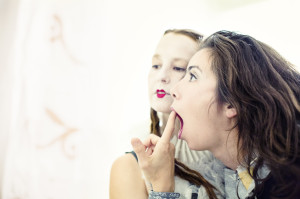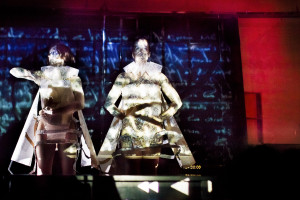Erika Tsimbrovsky and Avy K Productions place visual art on equal footing with music and dance, creating a perfect environment for exploring the relationship between movement and image. Performances are largely improvised and necessitate strong artists capable of observing the work of others and responding to it. At the same time they must bring their own powerful voice to the conversation. All the co-creators have total freedom within the structures of the work to create as needed moment by moment. The conceptual framework of each piece provides a common destination, yet each participant takes his/her own journey to get there.

Photo by Aleksey Bochkovsky
One of the first things I was interested in about Erika’s work was the ephemeral nature of it. She works in structured improv, and while some performances are more structured than others, every night is going to be a unique event. As such, any media employed must be as immediate as the dance itself.
As a lighting artist, our first major collaboration was a month-long installation/performance at SOMArts called The Book in July of 2011. During the week was a gallery show with paintings by Vadim Puyandaev, pictures and videos about the company, and a lighting installation I created. Every Friday was a performance. Some performances were only an hour or so long, others over three hours.
Because it was in an art gallery rather than a theater, I had to be a physical performer as well as lighting artist. I found myself weaving around dancers adjusting lighting throughout the evenings. And I had a blast. It was my first time physically performing since I was a kid. I’ve been involved in many performances designing lighting and video, but not as a performer on stage. I have some training in theatrical improvisation and The Book brought back my improv roots and allowed me to look at lighting more specifically as performance.
In this and other early collaborations, I only did lighting, but as Erika and I worked together more it became clear that my digital art would integrate seamlessly into these projects. My digital art ranges from loop-based video, to digital stills in the style of oil and watercolor paintings, to animation. My animations include both abstract work and more representational pieces rotoscoping film footage. Rotoscoping is a process wherein film footage is overdrawn, in this case digitally, to turn it into a frame by frame animation.
Much of my work is conceptual. I like to take an idea and abstract it out as far as I can go. This is why lighting resonates so strongly with me. It is inherently an abstract medium even when doing naturalistic work like recreating a sunset. This type of work and creative process seemed an obvious fit in the context of Erika’s performances, which often integrate live painting, improvisational musicians, and other dynamic elements. The open framework of her creative style encouraged me to move past the pure abstractions of lighting and bring digital media into my lighting environments.
In June of this year Avy K Productions had a residency at Paul Dresser Studios where we explored the use of projected media within an improvisational event. We developed both a visual vocabulary for the work as well as the technical tools for performance. This visual vocabulary included live looped video of the dancers as well as a deconstruction of form through digital manipulation. Beginning with straight video, the images were slowly morphed and manipulated into increasing abstractions until the whole thing dissolved into a field of floating particles like digital snow flurries. Much of this vocabulary we developed will be refined and presented during Ir/Rational at ODC this December.
In bringing my digital art into Avy K’s collaborative environment I wanted a more immediate approach than simple video playback allows. While some content will be created ahead of time, exact cues, crossfades and compositing needs to happen in real time. Finding an approach that would work required looking at tools that allow for the manipulation of media and image to be as live and specific as a dancer improvising with their partner.
I ended up building my own interactive playback system in Quartz Composer, an apple visual programming environment. Using a simple MIDI controller I can crossfade between content, set loop points for prerecorded or live input, adjust the speed and timing of clips, and manipulate the height and width of the projection thus mapping it to various objects, including dancers. This flexibility allows the video content to build around the conceptual structure developed in rehearsals and gives me near infinite control over the specifics of each performance.
Often one can set a series of video cues, as one can with lighting, and have them played back by an operator for the run. The system we developed during our residency at Paul Dresser Studio emerged through working with improvised dance and video for a week. Thus it is specific to both my method of working and the improvisational base of the company.
What attracted me to live video looping was precisely the ephemeral nature of Erika’s work. Because everything is improvised, even with structured improv, there are no repeating events. Each performance, each moment of performance, is unique. By capturing and looping segments of dance, it allows the dance to exist beyond itself. It turns the video into a partner in dialog with the dance, not merely a film playing along side it.
By capturing these moments I had to think through them as a choreographer or film director as much as a designer and visual artist. By combining different loops composited one over the other I found myself creating a second dance happening in response to the one being performed live by the dancers. Just as the body of one dancer impacted the movement of another, so too were these looped segments impacting the live dancers. Sometimes this presented a counterpoint to the movement on stage and other times a harmonious dance partner.

Photo by Aleksey Bochkovsky
This summer, we took this process further with a networked performance happening simultaneously in New York City and Oakland. A music event, performed by composer Alex Sigman at Spectrum in New York City, was broadcast to us live over a Skype connection in Oakland that Erika improvised a dance to. Working with her movement and the music, I played a live video set of looping content on which I overlaid looped video of her movement. The video was a mixture of urban backgrounds and abstract shifting geometric forms. The overlay of the one on the other, combined with Erika’s movement created a very dynamic visual space. This was then sent back to the music performance in New York and projected in front of the audience there in real time. Instead of weeks in an editing studio, we presented a live half hour dance movie made with no rehearsal.
These various experiments have helped guide us through the process for our upcoming work, Ir/Rational, that will play at ODC Theater in December. The piece inhabits two worlds. The worlds of two queens, Elizabeth and Mary, in conflict with one another. These two worlds morph from the physical to the digital over the course of the piece. Partly underwritten by a Lighting Artist in Dance grant from Dancers’ Group, our initial idea of experimental lighting sources is being expanded to include projected media.
The two dancers represent opposites yet are the same. They are discrete individuals yet they are reflections of one another. Engaged in deadly competition yet they are playing a game. We wanted to embody these dualities and similarities between the two dancers in the video content used for the piece. Right now, we are looking into shooting footage that will be rotoscoped into animations in the style of oil paintings. These animated paintings will then play along and against live sampled footage of the dancers, which will be manipulated into increasingly digital forms.
That experience of performative lighting during The Book will stand me in good stead. Right now we are talking about the live video components being mixed by me on stage. Rather than the traditional lighting and video operator hiding in the booth behind the audience, I will be on stage with dancers and musicians live mixing the visuals.
Ir/Rational will combine footage shot and edited ahead of time as well as live looped video and other manipulated live feeds to create worlds ranging from 16th century England to the inside of a computer game. The work, like all of Erika’s, is structured improv. More structured than either our Spectrum event or The Book, but still improvised. Ir/Rational looks to be our most sophisticated project along this line of creative exploration.
Ir/Rational will be performed Dec 7-8, 8pm at ODC Theater, SF

